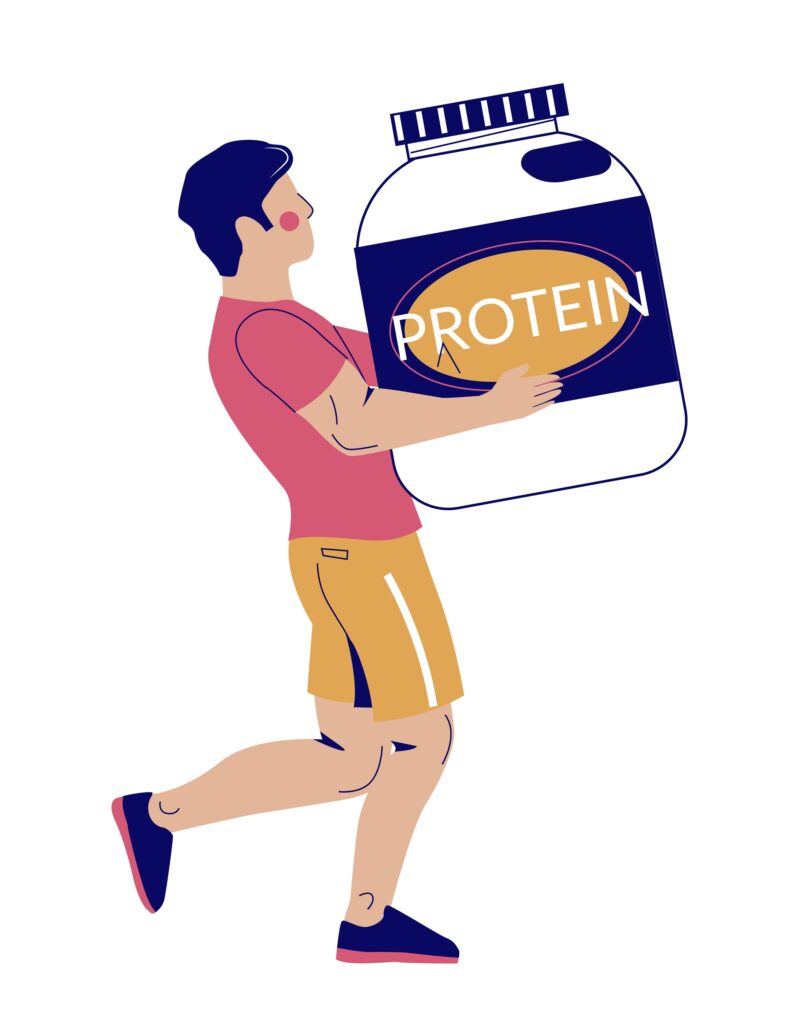A mutual acquaintance introduced me to Eric Mittenthal, Chief Strategy Officer of the North American Meat Institute. He had previously been Vice President of Sustainability. On our first call I joked that being the CSO of the North American Meat Institute was either an oxymoron or he’s a very busy guy! Eric took this in good humor and proceeded to tell me about what the meat industry is doing to progress towards global goals and what that actually means for consumers, policy makers, and thought leaders. I was fascinated and asked Eric if he’d be willing to do an interview with me. He kindly agreed to discuss his life, what brought him to his current role, and what continuous improvement means under the Protein PACT for the People, Animals & Climate of Tomorrow.
Eccles: Eric, thanks for taking the time to talk to me. Do you mind if we start off with you telling me about your childhood?

Eric Mittenthal, Chief Strategy Officer, North American Meat Institute | NORTH AMERICAN MEAT INSTITUTE
Mittenthal: I was born and raised in Atlanta, funnily enough with no agriculture background. My father is a doctor. I grew up as a city suburban kid, and I was into sports. Following in my father’s footsteps, I was very directed toward medicine because that is what I knew growing up. My brother became a doctor, but I found a different calling. I became interested in communications by doing radio in Ithaca, New York while I was working towards a psychology degree at Cornell University. I was on track to go to medical school, but I figured out that it was not the right path for me, so I decided to take a path that seemed interesting to me and got into broadcast journalism. I then worked as a reporter at several TV stations, and the next thing I knew, I was accepting a job in Washington, D.C. with the International Food Information Safety Council, where I led media relations for three years. Then in 2012 I was contacted by what was then the American Meat Institute (Meat Institute), and I have been there ever since.
My first role with the Meat Institute was as vice president of public affairs, during a time of crisis when there was a lot of misleading information about ground beef. So it was a trial by fire in helping to communicate some of the most challenging issues for this industry that is so heavily regulated and plays such a large part in Americans’ daily lives.
Eccles: Tell me more about the North American Meat Institute itself—when it started, what its purpose is, who are your members, and so forth.
Mittenthal: The Meat Institute traces its roots back to 1906, just after the passage of the Federal Meat Inspection Act, one of the first U.S. laws to set federal food processing standards. Originally called the American Meat Packers Association, the organization devoted much of its efforts in the early years to helping its nearly 300 member companies acclimate to the new federal inspection. In 2015, the North American Meat Institute was formed from the merger of the American Meat Institute and the North American Meat Association. The organization represents 95% of beef, pork, veal, and the majority of poultry products sold in the United States. The Meat Institute’s members are companies of all sizes from packers and processors to suppliers. Headquartered in Washington, D.C., the Meat Institute is known for our regulatory and technical expertise, advocacy with decision makers, and the strength and power of our convening platform. We are uniquely positioned to speak with one voice on behalf of members large and small throughout North America and our mission is focused on connecting people and resources to strengthen trust in the food we produce.
Eccles: Thanks for this helpful background. Could you elaborate a bit on your 300 members, like size range and how many are public companies?
Mittenthal: We have a very diverse membership with companies of all types. There are just 15 companies with more than 2000 employees working in meat processing. We have around 58 or so with 300-2,000 employees and then hundreds that are smaller than 300 employees.
Eccles: Thanks. Now, please tell me more about the institute’s vision for sustainability and how you support that vision as Chief Strategy officer.

Athletic muscular sportsman carrying huge protein powder jar stock illustration (Photo iStock)
Mittenthal: We know we need to demonstrate our alignment with customer’s (the buyers of our members’ products) and the end consumer‘s expectations. Dating back to 2018, leaders in the sector and on our Executive Board identified that meat was too often on the defensive but not in a position to proactively build trust and go out into the world with a really positive agenda, supported by evidence of the good work in our sector and the further improvements that are constantly being achieved.
So we created what was initially known as “Trust in Animal Protein” or “TAP,” a strategic initiative under which we developed a vision for continuous improvement and communications over the next 10 years. The objective is to sustain meat’s place on the menu and meet growing demand, while also implementing and verifying best practices for responsible production across the value chain. While TAP began as an initiative internal to the Meat Institute, it became clear that to really broaden our impact and amplify our results we needed to join up efforts all along the value chain. That led to the creation of a partner group committed to the TAP vision which ultimately came to be known as the Protein PACT for the People, Animals & Climate of Tomorrow.
As the Protein PACT has evolved, the way it is staffed within the organization has evolved. We initially created a Vice President of Sustainability role in 2019, recognizing that building out our capabilities in this space is a critical function of the organization. Throughout the development of our framework and strategy, our members’ support and buy-’in has been consistent and that presented the opportunity for the role to become Chief Strategy Officer, which was created specifically because sustainability and continuous improvement is our strategy.
Eccles: That sounds interesting. Please tell me more about the Protein PACT.
Mittenthal: The Protein PACT encompasses two things—the Meat Institute’s own continuous improvement framework which sets baselines and measures progress on more than 90 metrics, and the combined communications effort of the Meat Institute and our partners.
The Protein PACT vision unites partners across animal agriculture to transparently communicate their principles, practices, and proof of progress toward bold goals for healthy animals, healthy people, healthy communities, and a healthy planet. Protein PACT partners know it is imperative for the sector to build trust and ensure that consumers, customers, and decision makers know how animal-source foods align with their values and expectations. Through consumer research, we know that 98% of American households purchase meat, and we founded the Protein PACT to help reassure Americans’ decisions to eat meat are aligned with their values, including sustainability, which is more important than ever.
Eccles: What are the biggest challenges facing the industry?
Mittenthal: Great question! The biggest challenge isn’t just one topic or issue; it’s the big picture ensuring that consumers, customers, investors, and policy makers trust meat to align with their values and expectations. That’s why we’ve established the Protein PACT’s five key focus areas: (1) optimizing contribution to a healthy environment, (2) providing the best animal care, (3) supporting safe and diverse workplaces, (4) producing safe food without exception, and (5) providing a wide variety of high-quality protein for balanced diets.
For the Meat Institute to verify progress in these focus areas, we have set ambitious and measurable targets. We are in our second year of collecting data, and in the first year data already reflected an estimated 90% of meat sold in the United States. The Meat Institute aims for 100% of members to submit data on all metrics by 2030.

2030 copper arrow at satin black wall – 3D rendering illustration stock photo (Photo iStock)
Eccles: What kind of data are you looking for?
Mittenthal: By 2025, we aim for:
- 100% of NAMI members who handle animals to pass third party animal transport and handling audits, and 100% of members will require all suppliers to implement mandatory employee training and follow standards for animal care.
- To work with partners like the U.S. Department of Agriculture (USDA) and the NGO Feeding America to measure and help fill the protein gap, ensuring that families facing hunger have access to enough high-quality protein to meet dietary guidance.
By 2030, we aim for:
- 100% of NAMI members to have science-based greenhouse gas (GHG) reduction targets in line with the Paris Climate Agreement.
- The meat sector to further reduce workplace injuries by 50% (2019 baseline), on top of the 75% reduction achieved from 1999-2019.
Eccles: Wow! That’s very ambitious so good luck! Laudable though this is, the issue remains that eating meat is controversial to a number of people who say, “Eat less meat to save the planet.” What do you have to say to that? Do Americans eat too much meat?
Mittenthal: We all need to eat, and we all want to see our food choices have a positive impact on our health, on our communities, and on the environment around us. Sustainability is multi-faceted. As defined by the United Nations Food and Agriculture Organization (FAO), achieving sustainability requires three components: environmental, economic, and social.
At the Meat Institute, we believe that eating meat is not only compatible with sustainability, but also integral to achieving it; that is, we cannot achieve the sustainable, healthy future people need without meat. The first part of this equation has to do with understanding meat’s unique nutrition package—its “nutrient-density.”
The FAO recently concluded that “Meat, eggs and milk offer crucial sources of much-needed nutrients which cannot easily be obtained from plant-based foods.” Animal-source foods like meat, dairy, and eggs deliver important macro-nutrients like high-quality protein, as well as essential fatty acids and micro-nutrients like iron, calcium, zinc, and vitamin B12 that play a key role in health and development.
Consumption of animal-source foods varies around the world, but micro-nutrient deficiencies are common even in high-income populations. Iron and vitamin A are among the most common micronutrient deficiencies around the world, particularly in children and pregnant women. Globally, more than 1 in 2 preschool aged children (372 million) and 1.2 billion women of child-bearing age suffer from the lack of at least one of three micronutrients: iron, vitamin A, or zinc.
Eccles: Thanks for the nutritional tutorial! These kinds of facts are rarely mentioned in discussions about meat. But the fact remains that the production of meat comes with carbon emissions. The FAO has estimated that livestock account for 14.5% of anthropogenic carbon emissions. Beef, in particular, is particularly carbon intensive and cattle account for 65% of that total.

Global Warming Related Modern Flat Style Vector Illustration stock illustration (Photo iStock)
Mittenthal: Fair point. Of course, all foods need to also contribute to the health of our planet. As we discussed, the Meat Institute aims for 100% of members to have science-based GHG reduction targets by 2030. Today, 13 companies representing a large majority of meat sold in the United States have set or publicly committed to set targets approved by the Science Based Targets Initiative. About 80% of the establishments in our data collection process are already covered by company commitments to reduce GHGs.
Other Protein PACT partners have similarly ambitious goals. For example:
- The U.S. beef supply chain has committed to achieve climate neutrality by 2040.
- U.S. dairy aims to achieve GHG neutrality and other environmental stewardship goals by 2050.
- The U.S. pork sector has set a goal to reduce GHG emissions by 40% by 2030.
Recent decades show a proven track record of success in producing nutrient-dense animal source foods more sustainably than ever. Over the last 30-40 years:
- U.S. dairy farmers have cut emissions from each gallon of milk by nearly 20%, and with the lowest on-farm dairy emissions in the world.
- Ranchers have reduced emissions per pound of beef produced by more than 40% while also producing more than 66% more beef per animal.
- U.S. pig farmers have decreased water use by 25%, land use by nearly 76%, energy use by 7%, and have shrunk their carbon footprint by almost 8%.
Further achievements are within reach. We are doing the work to produce the food people need to thrive, while protecting the environment we all share.
Eccles: Aside from the environment, animal care seems to be another significant source of consumer demand. How do you approach that issue?
Mittenthal: While there are a lot of misconceptions about modern animal care, no one is more committed to raising healthy animals and providing the best animal care than farmers, ranchers, and all the companies who handle animals.
Farmers raising different animals follow species-specific animal care programs and standards. For example, the pork We Care commitment sets out principles that govern animal care, environmental protection, and food safety on the 67,000 pig farms around the country. Eighty-five percent of American beef comes from Beef Quality Assurance (BQA) certified farms and ranches.
Meat Institute members have reported that 75% of establishments that handle live animals have a comprehensive animal welfare program and 98% of establishments that conduct further processing require suppliers to maintain a written animal welfare program.
Animal care is at the heart of making safe, wholesome food. Without providing the best care, we can’t meet our other goals. At the Meat Institute, even before the Protein PACT, we have made a huge effort to be transparent about that care. Anyone interested can review our “Glass Walls” video series, narrated by renowned animal care expert Dr. Temple Grandin and which take viewers right inside meat plants to see animal care practices for themselves.

Logo of the North American Meat Institute | NORTH AMERICAN MEAT INSITUTE
Eccles: Thanks, Eric. This is also very useful information. One last question, if you don’t mind?
Mittenthal: Fire away, Bob!
Eccles: Thanks and I will! What’s next for the Protein PACT?
Mittenthal: This is only the beginning. We’ve spent the last three years building the concept and framework of the Protein PACT, both within our organization and with partners. We’ve gotten tremendous buy-in, and we have succeeded in things people thought might not be possible, like building a sector-wide dataset and establishing transparent baselines.
We now have the next few years to demonstrate that the Protein PACT works in the long run as a vehicle for driving continuous improvement. This will require even greater collaboration with partners across the supply chain, including our customers like consumer brands, food service and restaurants, and retailers. It is incumbent on all of us to streamline efforts and show that, working together, we can achieve our goals. Because it’s the right thing to do and because consumers demand nothing less.
Nothing about this is easy. There will be numerous gaps and major innovations and investments needed to fill those gaps. We are working to realign the mandate and mission of the Foundation for Meat & Poultry Research & Education to help identify and fill research gaps, and we look to all of our partners to find new ways each organization can contribute and ways in which we can collaborate to advance shared objectives.
Eccles: Thanks again for your time Eric. I learned a lot and I hope our interview will contribute to a balanced and discussion about the production and consumption of meat and its impact on climate change.
Mittenthal: Thanks for the opportunity and I hope so as well. We know we are at the center of an important and passionate debate. For this reason we take every opportunity we get to explain what we’re doing and to constructively engage with both supporters and critics.
SUBSCRIBE TO OUR NEWSLETTER
Subscribe our newsletter to receive the latest news, articles and exclusive podcasts every week

